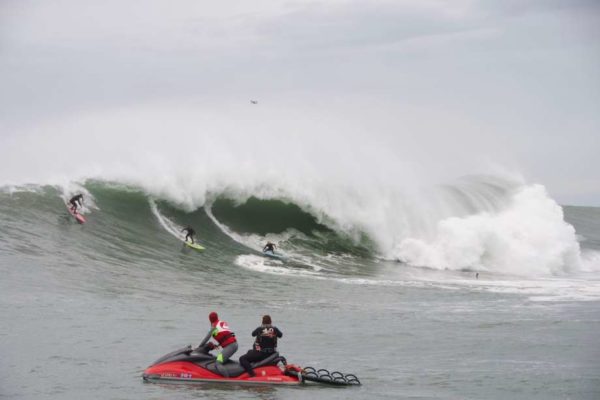Updated
-

Jet ski driver Sarah Stascavage tows surf photographer Ben Schutzer out to the Mavericks break off Half Moon Bay Calif., to take photographs on Dec. 13, 2019.
Jet ski driver Sarah Stascavage tows surf photographer Ben Schutzer out to the Mavericks break off Half Moon Bay Calif., to take photographs on Dec. 13, 2019.
Photo: Audrey Lambidakis
Image 1 of 24
Jet ski driver Sarah Stascavage tows surf photographer Ben Schutzer out to the Mavericks break off Half Moon Bay Calif., to take photographs on Dec. 13, 2019.
Jet ski driver Sarah Stascavage tows surf photographer Ben Schutzer out to the Mavericks break off Half Moon Bay Calif., to take photographs on Dec. 13, 2019.
Photo: Audrey Lambidakis
“I’m a broken surfer,” says photographer Ben Schutzer. “I can’t paddle into the waves anymore. I now surf through my camera.”
Schutzer, now 47, started surfing long before he began shooting photos. At age six you could find him riding the long, rolling waves of Malibu’s First Point at Surfrider Beach. He didn’t chase the giant waves at famed surf spot Mavericks until the 1990s when he said, “It was a bunch of yahoos out there trying to figure out the wave.”
There were no jet skis to help reach the break, nor inflatable vests for safety. Being out in the water was pure magic.
“It’s the best rush in the whole world,” he said. “There’s nothing better than surfing that wave. It’s pure awesomeness.” But after a horse riding accident and four shoulder surgeries, he hasn’t been on a board in five years. Now he stays connected to the water by photographing surfers shredding crests the size of mountains.
Schutzer has worked as a professional surf photographer with his company RunAMuck for 10 years, with stories in “Surfer” magazine and shoots for pros like dedicated big-wave rider Trevor Carlson. A couple years ago, he followed his dream to focus on the largest waves at Mavericks, a legendary break located a half-mile offshore from Pillar Point.
With a storm off the Aleutian Islands near Alaska expected to deliver 35 foot waves to Northern California this week, Schutzer makes the drive from Los Angeles to Half Moon Bay on Highway 101. Along the way he stops to field emails and calls from big-wave chargers such as Half Moon Bay’s Luca Padua and Nic Lamb, who won the last Titans of Mavericks competition in 2016.
Once Shutzer arrives in the Bay Area, he’ll make trips to and from the airport to pick up friends hoping to catch the surf on Wednesday, Thursday and Friday.
“Hawaii gets the swell a day before we do,” he said. “A lot of them jump to Hawaii and and then fly back here.”
When the right conditions coalesce, Mavericks is the premiere break for big wave surfing. First, the swell has to be giant — at least 20 feet, but ideally over 30, and even as tall as 60 feet. Also, the tide has to be low at the time the big breakers hit and the wind needs to be light and preferably blowing in an easterly direction.
“South winds are horrible,” he said. “They kill the whole face. We like an easterly wind best because it holds the wave up, but if it’s too strong, it blows the boards up. That’s when the big wipeouts happen.”
On Thursday and Friday, the National Weather Service forecasts good conditions with breakers well over 30 feet and winds relaxing Thursday afternoon into Friday. In years past, organizers of the Titans of Mavericks contest closely tracked the wave to determine whether to invite competitors from across the globe.
But this year, the World Surf League indefinitely canceled the event due to logistical challenges and the inability to run it in 2017 and 2018. Yet even without the official competition, serious surfers who spend the year at places like Jaws in Hawaii and Nazaré in Portugal flock to Mavericks every winter when the waves reach over two-stories tall.
Schutzer recalled one memorable wipe-out on a 45-foot-tall wave. “It’s like being smashed with a three-story building of water,” Schutzer explained.
ALSO: Record-setting 75-foot-tall wave recorded off California coast
Naturally it’s a different art than surfing, but photographing Mavericks is a huge challenge as the break is too far off the coast to capture up-close photos from land. Wearing a thick wetsuit and equipped with a waterproof camera, Schutzer gets closer to the wave on a boat or jet ski, with a driver maneuvering into the channel next to the break. Sometimes he jumps into the water for the perfect angle.
“You don’t just point and click,” he said. “All along you’re bouncing on the boat or the jet ski. It’s the closest thing I can do to surfing and bring stoke to everybody.”
Although he clearly misses being on a board, Schutzer still gets a surfer’s high just from being around “one of the gnarliest waves in the world.”
“The energy I get from sitting in the channel with the big waves … it feeds my soul. If I stay away from the ocean too long, I get moody. I get in a bad mood. The second waves come up, I get happy again. My energy runs off the tide.”
Amy Graff is a digital editor at SFGATE. Email: agraff@sfgate.com





Recent Comments